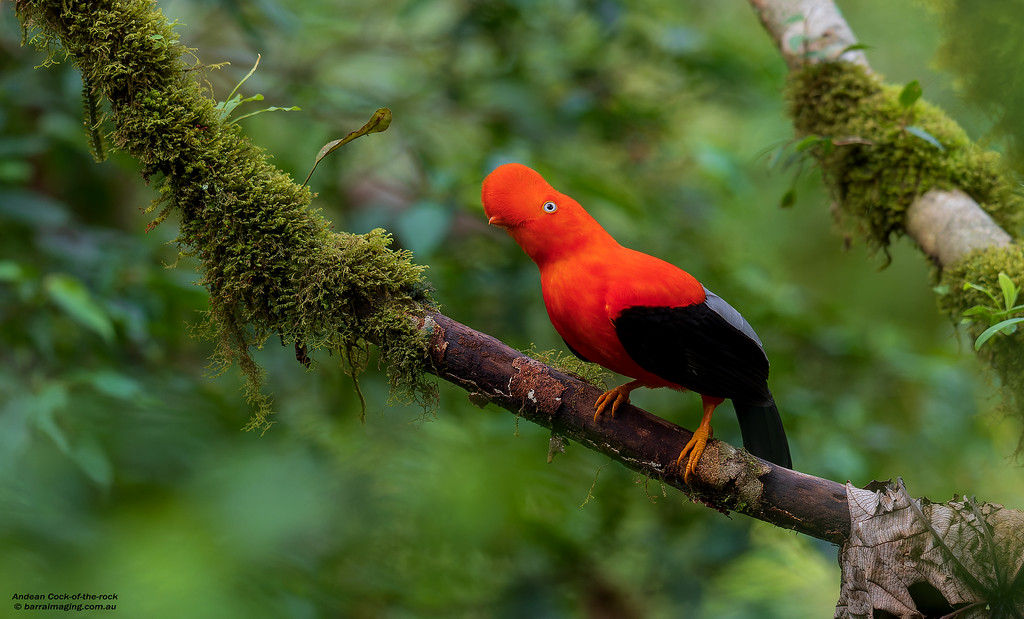The Andean Cock-of-the-Rock, a radiant orange bird with a disc-shaped crest, enlivens South America’s cloud forests with its bold, rasping croaks, a sound as vivid as its fiery feathers. Found in the Andes of Peru, Bolivia, and Ecuador, this lively songster gathers in raucous leks to court mates, its calls reverberating through fog-laden valleys. As Peru’s national bird, the Andean enchants birdwatchers and communities, yet its forest home faces increasing threats. This article explores the Andean Cock vocal talents, behaviors, cultural importance, and conservation needs, honoring its place as a cloud forest legend.

The Vibrant Song of the Fiery Andean Cock-of-the-Rock
A Croaking Spectacle
The Andean Cock-of-the-Rock is a visual and auditory marvel, its brilliant orange feathers and disc-like crest matched by a guttural croak that cuts through the Andean mist. Males, far brighter than females, use their calls to dominate leks—communal display grounds where they compete for mates. For example, their harsh, pig-like grunts and squawks create a cacophony, signaling strength and vitality. This fiery croaker’s vocal display is a cornerstone of its identity, mesmerizing those who hear it.
Cloud Forest Soundscapes
The Andean Cock-of-the-Rock thrives in the humid, moss-draped cloud forests of the Andes, at elevations between 500 and 2400 meters. Its calls resonate best in these dense, misty environments, where sound carries through ravines and over waterfalls. However, urban expansion near cities like Cusco encroaches on these habitats, muffling the orange songster’s voice. Its acoustic niche, as explored in our Birds by Region category, highlights the Andes’ role as a hotspot for avian symphonies.
Behavior and Ecology of the Cloud Forest Andean Cock-of-the-Rock
Lek Displays and Vocal Rivalry
The Andean Cock is renowned for its lekking behavior, where males gather at dawn and dusk to perform for females. Their croaks, combined with wing-flapping and bowing, create a theatrical show, each male vying to outshine rivals. For instance, louder, deeper calls often signal dominance, attracting discerning females. These vocal battles, detailed in our Bird Songs and Calls category.
Fruit-Feeding Ecology
As frugivores, Andean Cock-of-the-Rocks feed on wild fruits like berries and figs, dispersing seeds across cloud forests. Their diet supports forest regeneration, a vital role now threatened by deforestation. As a result, their foraging grounds are shrinking, impacting lek sites. The fiery croaker’s reliance on fruit trees ties it to the Andes’ ecological health, making its vocal presence a barometer of forest vitality.
Cultural Significance of the Orange Andean Cock-of-the-Rock
Indigenous Reverence
The Andean Cock, known locally as “tunki,” holds deep cultural value in Andean communities. Quechua and Aymara peoples view its fiery plumage and bold calls as symbols of fertility and the sun, weaving it into rituals and textiles. This reverence echoes the stories of extinct birds in our Historical Birds category, where avian voices shape cultural narratives. The orange songster’s croak is a living link to Andean heritage.
A Tourism and Artistic Muse
The Andean Cock-of-the-Rock’s vibrant calls and colors inspire Peru’s ecotourism, drawing visitors to reserves like Manu National Park. Its image graces postage stamps and local art, while its croaks feature in soundscapes for films and music. Moreover, birdwatching tours near urban areas like Quito amplify its fame, blending nature with culture. The cloud forest performer’s charisma drives initiatives to showcase South America’s rich biodiversity.
Conservation Challenges for the Fiery Andean Cock-of-the-Rock
Habitat Threats
The Andean Cock-of-the-Rock confronts serious risks from deforestation, fueled by farming, logging, and mining in the Andes. These activities disrupt lek sites, muting the fiery croaker’s distinctive calls. For example, infrastructure projects like roads near cloud forests interfere with breeding, as documented by Rainforest Foundation. Preserving these forests is essential to keep the Andean Cock song alive in the Andes.
Urban Encroachment and Solutions
As urban centers like La Paz grow, the Andean Cock is increasingly observed in forests near cities. While this adaptability is promising, noise pollution and habitat degradation threaten its survival. Conservation strategies, such as reforestation and protected sanctuaries, aim to secure lekking areas. Local community efforts to monitor populations further bolster the orange songster’s prospects, harmonizing urban development with wildlife preservation.
Why the Andean Cock-of-the-Rock Enchants Us
The Andean Cock, with its fiery plumage and croaking chorus, embodies the wild spirit of South America’s cloud forests. Its lek performances, cultural resonance, and ecological role make it a cherished icon, yet its survival hangs in the balance. From Indigenous myths to modern conservation, this bird bridges tradition and hope. In conclusion, the Andean Cock urges us to preserve its misty home, ensuring its vibrant calls echo for generations. Have you heard the Andean Cock or another bird’s striking call? Share your story in the comments and join our community of bird lovers!
